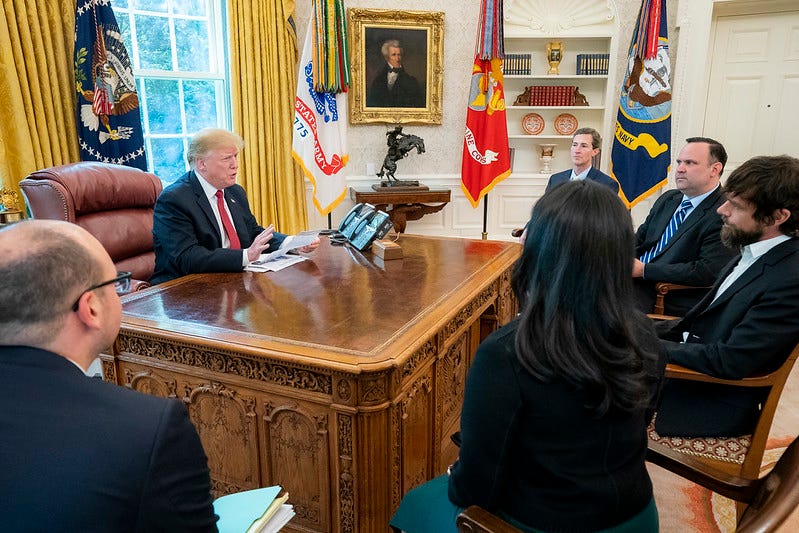
“The lethality of algorithms.”
The anatomy of digital censorship.
This is the second of two pieces on the practice of heresthetics. The first piece can be found here.
In Part 1 of this essay, I introduced the concept of heresthetics, the art of shaping the world via the “strategy value of sentences,” as William Riker put it when he delineated the concept 35 years ago in The Art of Political Persuasion, in the service of accomplishing a given (usually political) goal. All the examples cited had a common element: They involved the application of heresthetics in what we may as well call the analog (nondigital) world.
Now to the digital side. And now things get yet more worrisome, as cyber versions of heresthetical strategies bring us to a point when some of us—a frightening many, indeed—think censorship is somehow a matter worthy of debate. Beyond Riker’s heresthetical categories of agenda control, strategic voting, and manipulation of dimensions, I am convinced that a new heresthetical category has come into existence. This new category, which I call digital heresthetics, has emerged along with the rise of social media. Heresthetics, I will go so far as to say, is one reason these media can be dangerous places to linger.
Riker did not live to see the emergence of social media, as he passed away in 1993, a year before the first social media platform (GeoCities) debuted. Since that time, social media have evolved from (the relatively primitive) GeoCities to sophisticated platforms such as Facebook and Twitter. According to Pew Research, 72% of Americans now use social media and 53% of U.S. adults obtain news via social media. Politicians have also increasingly utilized social media for advertising purposes and messaging. Former President Donald Trump was notorious for using Twitter during his presidency, tweeting more than 25,000 times while in office. Alexandria Ocasio–Cortez, a “progressive” Democratic member of the House of Representatives and as such a rising political star, has used social media to great personal effect, with millions of followers across multiple social media platforms.
The increase in social media usage for the multitude of purposes mentioned above has turned social media into the equivalent of a privatized town square governed by what some are calling “the fourth branch of government.” Permit me to put it this way: There is litter on the village green.
Riker knew nothing of all this, of course, and we are left to wonder what he would have made of it. And this is where digital heresthetics, the algorithmic manipulation of “the strategy value of sentences” in social media communication, comes into play. In a world where humans increasingly rely on this “privatized town square” for communication, this manipulation, left unchecked, could metastasize into outright censorship, neutralize dissent and free speech, and usher in an authoritarian future.
This is not an incipient danger. Step by step, we are advancing—or regressing, better put—into an information environment wherein censorship that intimately involves heresthetical practices is not merely tolerated but embraced.
Digital heresthetics takes a variety of forms. What follows is by no means a comprehensive list of these forms. These are merely some of the more prominent types of digital heresthetical techniques.
“Down-ranking” involves reducing the frequency of appearance of social media posts such as those concerned with politics. Facebook recently announced that it was taking steps to reduce the appearance of political posts in its news feed and Twitter has announced its intent to do the same on its platform. The government pressure on social media companies to employ down-ranking and other digital heresthetical measures have intensified in recent years, with some commentators even endorsing the Chinese model for internet governance.
“Sock-puppetry” involves the use of fake social media accounts to generate support for a particular cause or argument (a sybil attack) or to put a particular cause in a bad light (straw-puppetry). Various political entities across the planet, such as Turkey, Thailand, the United States, and China have been accused of using sock puppets to boost support for various causes. A particularly vivid U.S. example of sock puppetry came to light in 2018 during a Twitter attack on Bernie Sanders by a swarm of bot accounts boosting Hillary Clinton.
Another digital heresthetical technique is “shadow-banning,” or “ghost- banning.” This is the practice of allowing social media users to post material but, unknown to the users who post said material, their posts are rendered invisible to other members of the social media community. This technique, used in a variety of digital environments such as Reddit, Instagram, and Twitter, was originally developed to inhibit disruption of electronic communication but is now also used to influence political discourse on social media.
In 2018, it was revealed that several Republican members of U.S. Congress were being shadow-banned on Twitter. In 2015, Twitter faced accusations of shadow-banning users who posted materials related to an Intercept report on assassinations-by-drone attacks in the Middle East. Lamely enough, Twitter has claimed that shadow-banning is mostly due to technical glitches, but credible research suggests otherwise. Ironically, prior to the writing of this article, my own Twitter account was placed under a short-term shadow-ban, which I verified by going to this site. The reasons for this ban were never made clear.
The final digital heresthetical technique I will mention is a permanent banning or removal of one’s account on a social media platform—a blunt instrument by any measure. Removals or bans supposedly occur due to repeated violation of a social media platform’s “rules of conduct” or “community standards,” or due to threats of violence.
Some recent examples of a social media ban (of the countless many available to anyone who cares to look):
⁋ Dr. Robert Malone, the father of mRNA vaccine technology, recently had his LinkedIn account shut down, possibly due to recent discussions about using Ivermectin as a potential treatment against Covid–19.
⁋ In the political sphere, a demonstration of the power of social media cancellation was on full display after the storming of the Capitol on 6 January. The then-president of the United States, Donald Trump, with more than 80 million Twitter followers and a history of tens of thousands of Twitter posts, had his Twitter account permanently removed due to accusations of encouraging violence by his supporters. Trump’s final tweet was the following: “To all of those who have asked, I will not be going to the Inauguration on January 20th.” Following the Twitter ban, Trump was banned from a number of other social media platforms, effectively removing him from the 21st century town square.
⁋ Another more recent and ominous example is the revelation by White House press secretary Jen Psaki that the White House is in regular communication with Facebook with regard to censoring misinformative information. Indeed, the mask slipped even more when Psaki advocated banning troublesome individuals across multiple social platforms. As Psaki put it: You shouldn’t be banned from one platform and not others.
This increasingly marked trend should alarm every single one of us. Even Bernie Sanders, staunch opponent of Trump, had this to say about the banning of Trump from Twitter:
But if you’re asking me, do I feel particularly comfortable that the president, the then-president of the United States, could not express his views on Twitter? I don’t feel comfortable about it. Now, I don’t know what the answer is. Do you want to have hate speech and conspiracy theories traveling all over this country? No. Do you want the internet to be used for authoritarian purposes and insurrection, if you like? No, you don’t. So how do you balance that? I don’t know, but it is an issue that we have got to be thinking about. Because if anybody who thinks… yesterday it was Donald Trump who was banned and tomorrow it could be somebody else who has a very different point of view.”
It is digital heresthetics that social media now employ as they proceed to impose upon us a censorship regime at the scandalous urging of the federal government—so presenting a threat to democracy and free speech greater than any we have seen at least since the dreadful excesses of the Cold War and in all likelihood further back in history than that. How can one evaluate the strategy value of a sentence when sentences aren’t even visible (via shadow-banning or down-ranking)?
Let us be clear. The silencing of a sitting president across a broad spectrum of social media, no matter how repugnant his online behavior, is terrifying. Could one envision the silencing of a president (for example, across all major television networks) in the pre-social media era? The thought is preposterous. Let us call the proper guidepost here the Skokie Principle, after those right-thinking attorneys at the American Civil Liberties Union, some of them Jews, who in 1977 defended the right of an American Nazi group to march through Skokie, an Illinois town with a large Jewish population. Nothing to argue about: Either you are able to defend free speech with the disinterest our public space asks of us, or you think censorship is something worthy of debate.
We have lost our way in the matter of disinterest since then. We simply cannot manage it. Even the ACLU can no longer see straight. Somehow we are supposed to think there is something called good censorship and something called bad censorship. Shame on all those who advance this pernicious distinction.
Perhaps the “fourth branch of government” now needs to be put in its place. There are growing calls for government regulation of social media companies, if not outright conversion of these companies into public utilities. The problem with this strategy is that much of the censorship we are currently seeing is at the behest of the government as it arm-twists Silicon Valley and then disingenuously claims there is no official censorship in our republic. Perhaps the solution is to address the underlying material causes (such as income inequality and deindustrialization) behind the political polarization inside the U.S. instead of binding the citizenry in algorithmic chains.


